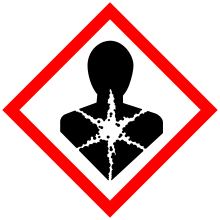Chloromethane
 | |||
| |||
| Names | |||
|---|---|---|---|
| IUPAC name
Chloromethane[1] | |||
| Other names | |||
| Identifiers | |||
| 74-87-3 | |||
| 3D model (Jmol) | Interactive image | ||
| 1696839 | |||
| ChEBI | CHEBI:36014 | ||
| ChEMBL | ChEMBL117545 | ||
| ChemSpider | 6087 | ||
| ECHA InfoCard | 100.000.744 | ||
| EC Number | 200-817-4 | ||
| 24898 | |||
| KEGG | C19446 | ||
| MeSH | Methyl+Chloride | ||
| PubChem | 6327 | ||
| RTECS number | PA6300000 | ||
| UNII | A6R43525YO | ||
| UN number | 1063 | ||
| |||
| |||
| Properties | |||
| CH3Cl | |||
| Molar mass | 50.49 g·mol−1 | ||
| Appearance | Colorless gas | ||
| Odor | Faint, sweet odor[3] | ||
| Density | 1.003 g/mL (-23.8 °C, liquid)[2]2.3065 g/L (0 °C, gas)[2] | ||
| Melting point | −97.4 °C (−143.3 °F; 175.8 K)[2] | ||
| Boiling point | −23.8 °C (−10.8 °F; 249.3 K)[2] | ||
| 5.325 g L−1 | |||
| log P | 1.113 | ||
| Vapor pressure | 506.09 kPa (at 20 °C (68 °F)) | ||
| Henry's law constant (kH) |
940 nmol Pa−1 kg−1 | ||
| Structure | |||
| Tetragonal | |||
| Tetrahedron | |||
| Thermochemistry | |||
| Std molar entropy (S |
234.36 J K−1 mol−1 | ||
| Std enthalpy of formation (ΔfH |
−83.68 kJ mol−1 | ||
| Std enthalpy of combustion (ΔcH |
−764.5–−763.5 kJ mol−1 | ||
| Hazards | |||
| Main hazards | carcinogen | ||
| Safety data sheet | See: data page | ||
| GHS pictograms |   | ||
| GHS signal word | DANGER | ||
| H220, H351, H373 | |||
| P210, P281, P410+403 | |||
| EU classification (DSD) |
| ||
| R-phrases | R12, R40, R48/20 | ||
| S-phrases | (S2), S16, S33 | ||
| NFPA 704 | |||
| Flash point | −20 °C (−4 °F; 253 K)[2] | ||
| 625 °C (1,157 °F; 898 K)[2] | |||
| Explosive limits | 8.1%-17.4%[3] | ||
| Lethal dose or concentration (LD, LC): | |||
| LD50 (median dose) |
1800 mg/kg (oral, rat)[2] 5.3 mg/L/4 h (inhalation, rat)[2] | ||
| LC50 (median concentration) |
72,000 ppm (rat, 30 min) 2200 ppm (mouse, 6 hr) 2760 ppm (mammal, 4 hr) 2524 ppm (rat, 4 hr)[4] | ||
| LCLo (lowest published) |
20,000 ppm (guinea pig, 2 hr) 14,661 ppm (dog, 6 hr)[4] | ||
| US health exposure limits (NIOSH): | |||
| PEL (Permissible) |
TWA 100 ppm C 200 ppm 300 ppm (5-minute maximum peak in any 3 hours)[3] | ||
| REL (Recommended) |
Ca[3] | ||
| IDLH (Immediate danger) |
Ca [2000 ppm][3] | ||
| Related compounds | |||
| Related alkanes |
|||
| Related compounds |
2-Chloroethanol | ||
| Supplementary data page | |||
| Refractive index (n), Dielectric constant (εr), etc. | |||
| Thermodynamic data |
Phase behaviour solid–liquid–gas | ||
| UV, IR, NMR, MS | |||
| Except where otherwise noted, data are given for materials in their standard state (at 25 °C [77 °F], 100 kPa). | |||
| | |||
| Infobox references | |||
Chloromethane, also called methyl chloride, Refrigerant-40, R-40 or HCC 40, is a chemical compound of the group of organic compounds called haloalkanes. It was once widely used as a refrigerant. It is a colorless extremely flammable gas with a mildly sweet odor. Due to concerns about its toxicity, it is no longer present in consumer products. Chloromethane was first synthesized by the French chemists Jean-Baptiste Dumas and Eugene Peligot in 1835 by boiling a mixture of methanol, sulfuric acid, and sodium chloride. This method is similar to that used today.
Occurrence
Chloromethane is the most abundant organohalogen, anthropogenic or natural, in the atmosphere.
Marine
Laboratory cultures of marine phytoplankton (Phaeodactylum tricornutum, Phaeocystis sp., Thalassiosira weissflogii, Chaetoceros calcitrans, Isochrysis sp., Porphyridium sp., Synechococcus sp., Tetraselmis sp., Prorocentrum sp., and Emiliana huxleyi) produce CH3Cl, but in relatively insignificant amounts.[5][6] An extensive study of 30 species of polar macroalgae revealed the release of significant amounts of CH3Cl in only Gigartina skottsbergii and Gymnogongrus antarcticus.[7]
Biogenesis
The salt marsh plant Batis maritima contains the enzyme methyl chloride transferase that catalyzes the synthesis of CH3Cl from S-adenosine-L-methionine and chloride.[8] This protein has been purified and expressed in E. coli, and seems to be present in other organisms such as white rot fungi (Phellinus pomaceus), red algae (Endocladia muricata), and the ice plant (Mesembryanthemum crystallinum), each of which is a known CH3Cl producer.[8][9]
Production
Large amounts of chloromethane are produced naturally in the oceans by the action of sunlight on biomass and chlorine in sea foam. However, all chloromethane that is used in industry is produced synthetically.
Most chloromethane is prepared by reacting methanol with hydrogen chloride, according to the chemical equation
This can be carried out either by bubbling hydrogen chloride gas through boiling methanol with or without a zinc chloride catalyst, or by passing combined methanol and hydrogen chloride vapors over an alumina catalyst at 350 °C (662 °F).
A smaller amount of chloromethane is produced by heating a mixture of methane and chlorine to over 400 °C (752 °F). However, this method also results in more highly chlorinated compounds such as dichloromethane, chloroform, and carbon tetrachloride and is usually only used when these other products are also desired.
Uses
Chloromethane was a widely used refrigerant, but its use has been discontinued due to its toxicity and flammability. Chloromethane was also once used for producing lead-based gasoline additives (tetramethyllead).
The most important use of chloromethane today is as a chemical intermediate in the production of silicone polymers. Smaller quantities are used as a solvent in the manufacture of butyl rubber and in petroleum refining.
Chloromethane is employed as a methylating and chlorinating agent in organic chemistry. It is also used in a variety of other fields: as an extractant for greases oils and resins, as a propellant and blowing agent in polystyrene foam production, as a local anesthetic, as an intermediate in drug manufacturing, as a catalyst carrier in low-temperature polymerization, as a fluid for thermometric and thermostatic equipment, and as a herbicide.
Safety
Inhalation of chloromethane gas produces central nervous system effects similar to drug intoxication. Exposure may cause drowsiness, dizziness, or confusion and difficulty breathing, walking or speaking may occur. At higher concentrations, paralysis, seizures, and coma can result.
In case of ingestion, nausea and vomiting may occur. Skin contact, when in the form of a refrigerated liquid, may result in frostbite. Contact with the eyes may result in dim vision, and widely dilated pupils that react slowly to changes in light.
Chronic exposure to chloromethane has been linked to birth defects in mice. In humans, exposure to chloromethane during pregnancy may cause the fetus' lower spinal column, pelvis, and legs to form incorrectly, but this has not been conclusively demonstrated.
References
- ↑ "Methyl Chloride - Compound Summary". PubChem Compound. USA: National Center for Biotechnology Information. 26 March 2005. Retrieved 23 June 2012.
- 1 2 3 4 5 6 7 8 9 10 11 Record in the GESTIS Substance Database of the IFA
- 1 2 3 4 5 "NIOSH Pocket Guide to Chemical Hazards #0403". National Institute for Occupational Safety and Health (NIOSH).
- 1 2 "Methyl chloride". Immediately Dangerous to Life and Health. National Institute for Occupational Safety and Health (NIOSH).
- ↑ Scarratt MG, Moore RM (1996). "Production of Methyl Chloride and Methyl Bromide in Laboratory Cultures of Marine Phytoplankton". Mar Chem. 54 (3–4): 263. doi:10.1016/0304-4203(96)00036-9.
- ↑ Scarratt MG, Moore RM (1998). "Production of Methyl Bromide and Methyl Chloride in Laboratory Cultures of Marine Phytoplankton II". Mar Chem. 59 (3–4): 311. doi:10.1016/S0304-4203(97)00092-3.
- ↑ Laturnus F (2001). "Marine Macroalgae in Polar Regions as Natural Sources for Volatile Organohalogens". Environ Sci Pollut Res. 8 (2): 103. doi:10.1007/BF02987302.
- 1 2 Ni X, Hager LP (1998). "cDNA Cloning of Batis maritima Methyl Chloride Transferase and Purification of the Enzyme". Proc Natl Acad Sci USA. 95 (22): 12866–71. doi:10.1073/pnas.95.22.12866. PMC 23635
 . PMID 9789006.
. PMID 9789006. - ↑ Ni X, Hager LP (1999). "Expression of Batis maritima Methyl Chloride Transferase in Escherichia coli". Proc Natl Acad Sci USA. 96 (7): 3611–5. doi:10.1073/pnas.96.7.3611. PMC 22342
 . PMID 10097085.
. PMID 10097085.
External links
- International Chemical Safety Card 0419
- "NIOSH Pocket Guide to Chemical Hazards #0403". National Institute for Occupational Safety and Health (NIOSH).
- Data sheet at inchem.org
- Toxicological information
- Information about chloromethane
- Concise International Chemical Assessment Document 28 on chloromethane
- IARC Summaries & Evaluations Vol. 71 (1999)


